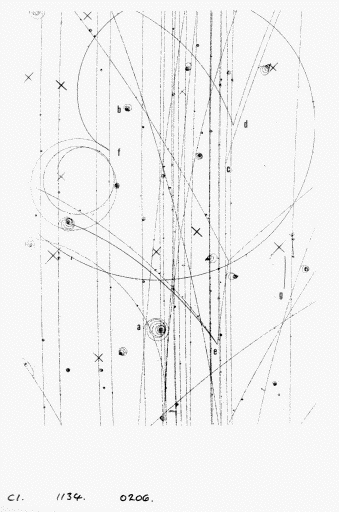 |
High School
Teachers at CERN |
 |
|
| WWW.CERN.CH |  |
||
 |
High School
Teachers at CERN |
 |
|
| WWW.CERN.CH |  |
||
The bubble chamber
The bubble chamber is no longer in wide use for Particle Physics experiments, but the photographs that these machines produced are excellent for 'seeing' particles and the way that they behave. Therefore they form an excellent teaching tool, and use ideas - not unlike the physics of the more familiar cloud chamber - which is easy to understand. We think they are BRILLIANT!
The article by Goronwy Tudor Jones gives an excellent introduction to the device.
How to analyze a picture. Powerpoint presentation.
www.ep.ph.bham.ac.uk/user/gron/bcpix/ Bubble chamber pictures with descriptions.
An Introduction.
The Bubble Chamber - the student-friendly particle detector.
Following trails Detectors The Bubble Chamber How long are the tracks? A simple calculation
Taking the next picture Why are bubble chamber picture so useful? Developing your own materials
Following trails.
If two aeroplanes with vapor trails behind them were to approach each other, circle around, and then go their separate ways, the fact that they had done so would be apparent for quite a while. A permanent record of the encounter could be obtained by taking a photograph of the vapor trails.
Detectors.
A particle detector is an instrument that can record the passage of particles through it. From a teaching point of view, the bubble chamber is a particularly valuable detector because it provides a real photograph of the trajectories of charged particles travelling though it. The only processing involved is in the photographic dark room. The dark lines on this photograph are an example.

There is an introduction to particle detectors, with particular reference to the bubble chamber. This article contains a general introduction to bubble chambers (followed by a careful derivation of the rate at which charged particles lose energy by ionization, dE/dx; suitable for first-year undergraduates).
The Bubble Chamber.
The bubble chamber consists of a tank of unstable transparent liquid - superheated hydrogen in our case. When a charged particle forces its way through the liquid, the energy deposited initiates boiling along the path, leaving a trail of tiny bubbles.
The superheated liquid is prepared by starting with the very cold liquid under pressure (about 5 atmospheres and 3K) and then, just before the particle beam arrives, the pressure is reduced suddenly by expanding the volume by about 1% by means of a piston.
Gargamelle, showing the cylindrical chamber and the electromagnetsHow long are the tracks?
After the particles have passed through the liquid, the bubbles are allowed to expand until they are a few tenths of a millimeter across, big enough to be photographed by flash illumination. To enable physicists to reconstruct the event in three dimensions, photographs from more than one camera are needed.
The relativistic particles cross the few meters of liquid in a few nanoseconds (1ns = 10-9s); the growth time of the bubbles is about a million times longer, about 10ms.
A simple calculation.
Assuming the particles are travelling at the speed of light (and most are quite close to this) how far would they travel in 1 ns?
Light travels at 3 x 108 m/s so in 10-9 s the light would travel 3 x 10-1 m or 30 cm, roughly 1m in 3ns.
Taking the next picture.
Once the photographs are taken (more than one view is needed to reconstruct the events in 3D), the bubbles are collapsed by recompressing the liquid, and the bubble chamber is prepared for the next burst of particles. This is quite slow process - maybe a few seconds - so the number of pictures is limited and the analysis of them is labor intensive. Modern detectors allow many thousands of events per second, and the images are computer generated; bubble chambers are no longer used.
Although extinct, bubble chamber pictures are remembered fondly, like dinosaurs. Unlike dinosaurs they provide a direct way of ëseeingí events that are real today.
Why are bubble chamber pictures so useful?
The great advantage is their ability to pick up details of a complicated interaction, and by following the trails of bubbles one can see subsequent interactions and decays of the products of the initial interaction.
Furthermore the principles by which the pictures are made and analyzed are easily understood.
Develop your own material.
To stimulate ideas about developing teaching materials from the resource material provided above, we draw attention to bubble chamber activities - Seeing Particles (with exercises) - developed by Peter Watkins (University of Birmingham) for first-year undergraduates.
You may now like to look at more detailed material.
© CERN and High School Teachers Programme at CERN Last modified: 28 June 2002